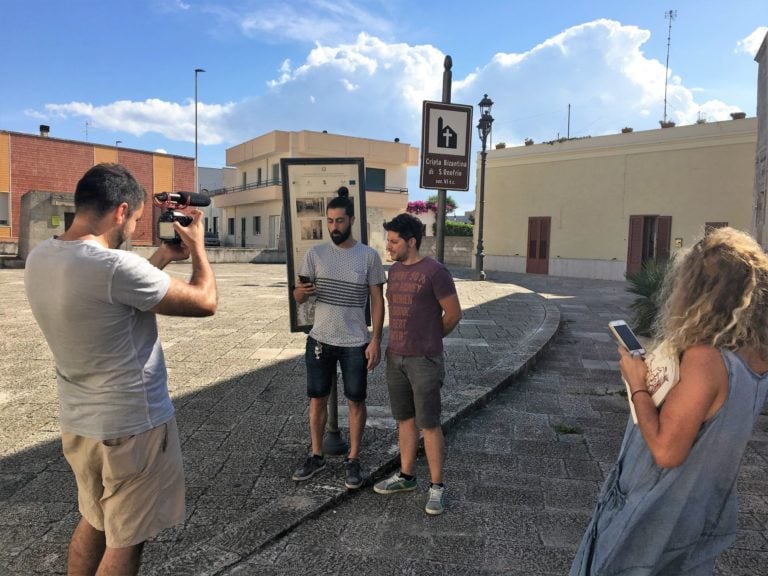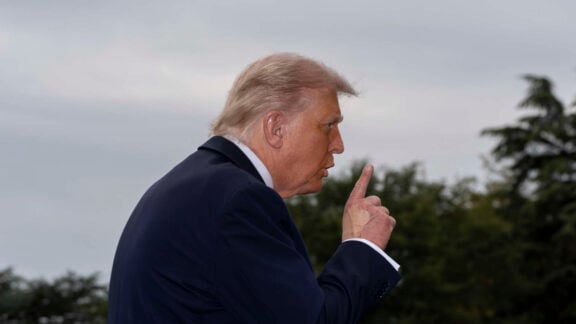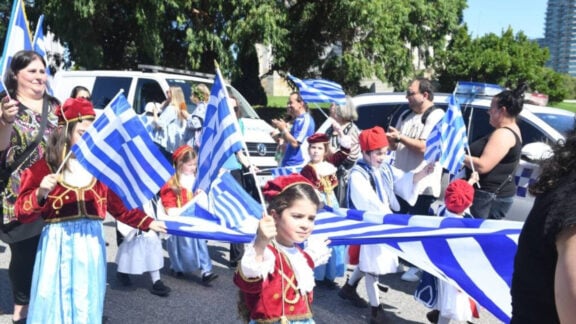The opening scene of our new documentary said it all – ‘this is not a police chase, it’s a Greek chase’ – as a friendly Italian allowed us to follow him to find the Griko-speaking town of Calimera that we had come to experience.
Apulia, also known as Puglia, is the home of 13 Griko towns and a few thousand Griko speakers. Once upon a time, a visitor to Calimera and Apulia would not have needed an Italian stranger to follow in order to find the descendants of the Hellenes, Griko speakers, for their dialect was the lingua franca of the region until recent centuries.
I first visited Apulia with my then girlfriend in 2002. We made the trek after an inspiring few days visiting the Greko speakers of Calabria, a trip we will always be thankful to Carmelo Nucera, Professor Filippo Violi and writer Pat Porpiglia who became our passports to the Greko, which is a slightly different dialect to the Griko of Apulia. I vowed to return one day to document both Calabria and Apulia for the audience Down Under, especially as we had thought at the time that these people were in the last generation.
Fast forward to over 16 years and 20 kilos later, my London-based filmmaker buddy Basil Genimahaliotis and I made the trek to Calabria, and in Apulia we were joined by Greek-Italian Ida Zerva. She is not a Griko speaker, however she is a gracious host, allowing us to stay, eat Greek food, brainstorm and drink Italian coffee. We will never forget the seven-course meal she made for us on Day One, complete with Lesvos ouzo.
As an old friend who was meant to be our translator for any Italian problemos, it soon became obvious that Ida was more enthusiastic about the towns and soon became friends with most of the older Griko speakers we encountered.
These towns are about an hour from where Ida lives. Each day we would drive out to see the living Griko history.
You enter a town which proudly boasts the name of the town in Griko, and you find the piazza. Sitting in a square listening to Griko and having a coffee was a treat. This is a language that predates Modern Greek, and certainly was evident during the Byzantine Greek epoch of Apulia. It can be argued that the language goes back to the ancient Hellenes who dominated the region, when it was known as Greater Greece, or rather, Magna Graecia.
READ MORE: Magna Graecia: How a dark cloud is lifting from the Calabrian Greko

Magna Graecia was the term the Latins and Romans gave the Greek speaking south of Italia, which first hosted Greek settlements commencing around 2800 to 2700 BC. Neapolis, Taranto, Poseidonia, Reggium, Locri, Messina, brilliant Syracuse, the Byzantine stronghold and home to Saint Nicholas’ bones of Bari, are just some of the ancient Greek cities. Pyrrhus at one time ventured into Magna Graecia to fight the Romans and the Carthaginian general Hannibal counted on the Greek cities as supporters when he was busy defeating the Romans in 216.
The Italian peninsular was truly divided into Greek and Roman and had it not been for the weakening of Macedon and Epirote powers, and the retreat of an undefeated Pyrrhus and Hannibal respectively, Greek may have been the language of the entire Italy. In fact, the Byzantine Empire controlled Rome, Venice, Ravenna and a good chunk of upper Italy for centuries. The first Doge of Venice was a Greek from Sicily and a number of Popes were Greek! Divine facts.
For those keen on the Greek history, Apulia will have your heart racing. The landscape is mainly flat in busy areas to make it easy for traversing and is covered in olives. There are moments when we felt as though we were in Greece thanks to the olive groves, Ida talking in Greek and the Griko signs.
Australian writer and lawyer Costa Vertzayias had visited here in the 1980s as did Professor Vrasidas Karalis from the University of Sydney, who spent several months studying the Griko for a thesis. They have both spoken to me about the Griko language and the culture, the people and how the proximity to Greece helped keep the language prominent. In a book Costa had written in 1990, he also broke down some of the differences between Griko and Greko, providing a great roadmap for us Aussies to locate these towns.
READ MORE: Documentary ‘Mykonos: The Other Side’ to make Foxtel debut

Decline of Griko
I have to agree, the proximity to Greece helped, for Calabria is surrounded by mountains and is further away from Greece. A ferry to Bari or Brindisi is easy enough. Additionally, the region remained a Constantinople held province until 1071 (temporarily again 1155 – 1158). With the fall of the Byzantine Empire and then Morea in the 1400s, many Greek speakers came here and to Venice, ensuring the Greek language remained prominent. It wasn’t until the Vatican, disappointingly, forced a change of Greek churches and monasteries between the 15th – 17th Centuries. This helped precipitate a decline of the Griko language.
The decline is evident and most of the young people these days are not fluent, if at all, in Griko. As we parked our vehicle at John F Kennedy Street (a real president if ever there was one) in Calimera and walked through the shops, we struggled to locate Griko speakers. One shop displayed a poignant sign: Ettosu milume o Griko. It was Ida who excitedly asked the people if they were Griko. They explained they had heritage, though they did not speak it fluently. Their Griko colleagues were not here, and instead they would take us across the piazza to meet a large number of elderly Griko! Their exact words were, “If that is ok!” Somehow we had hit the jackpot as we met a number of men and the renown poet Cici Cafaro. After reciting us poetry, he took us to his home. Stopping occasionally to recite more Griko poetry. His casa was a monument to Griko, his work and life. It is a mini museum and a privilege to have been there. In fact, there are other monuments and a Greek museum in Calimera, Griko murals and poetry on walls too.
We also met an elderly couple who run the fruit shop. As an adult, I probably only cried when my uncle passed away in Porto Heli and my friend Tekno Manos. Looking at these beautiful people, deep into their 80s, speaking in Griko, I could feel a tear well up. I had to turn from the group to make sure this Mr Adonis wasn’t seen to be weak, focussing on a beach bar in Lesvos to steady me. You see, these are people who hold on to the language and link our past. They were proud of their son who creates Greek sculptures and talked about him for a while and how happy they were to see us. Really, it was me who was proud to share this moment with them.
Moving to some other inspiring people, we met fluent Griko speaker Dr Renato Colaci and his wife, Melena Pascali. Both were lovely people, articulate and importantly around the 40 year old age group. Renato had accompanied us to Cici’s casa and was a font of knowledge. It is people like Renato who will help preserve the culture and language. He told me how his daughter doesn’t speak much Griko, but she does ‘speak Greek whenever she visits Greece!”
We also met Daniele Palma and his wife Delores Greco. Cici had sung poetry and it was no different here. Sitting at the home with Ida asking a range of questions in Modern Greek, I sat back and listened intently to the answers in Griko. We soon discovered that Daniele was making a difference, teaching the Griko dialect and along with his wife, they are guardians to a number of poems and songs that have been passed down by the Griko over the years. The couple sang us a Griko song, for me it was as if I was at Epidavros; for this is oral history, music to my ears. Beautiful sounds we cannot allow to disappear.
Daniele repeated the point about declining numbers of speakers. He was also quick to highlight that the Griko towns are in a close proximity to each other. Unlike Calabria where rugged terrain can make it hard to reach some of the locations in times gone past such as the old Roghudi, here it’s a simple drive ensuring a constant stream of people to connect with the Griko.
The traditional eleven Griko towns have a medieval feel meets sandstone, with lush countryside surrounds. Each town belongs to ‘The Union of the Towns of Grecìa Salentina – Unione dei Comuni della Grecìa Salentina.’ This became official in 1966 and in 2007, Carpignano Salentino and Cutrofiano joined them, though there are no Griko speakers here, just a consciousness of their Griko heritage.
The Union coordinates teaching of the language at school and promotes the preservation of the culture. You will see their Kalos Irthate signs every time you enter a town.
With the help of Costa Vertzayias’ book, we easily navigated the towns, understanding location and the numbers of Griko remaining. It is probable that each town has dozens to hundreds of speakers of varying degrees of knowledge. It helped me as I know no Italian, not even enough to order an uno con café latte. We met Griko speakers, be at gardens, parks, churches or shops in the following: Calimera, Martano, Castrignano dei Greci, Soleto, Sternatia, Martignano and Zollino.
At Zollino we met and said ‘kalimera’ to Pavlos, again someone in my age group.
READ MORE: Sismanoglio: A beacon of Greek culture
He owns the excellent Top Orange and ideal to visit if you want great local sweets, coffee, top service and a few Griko speakers hanging about.
After a long day of travelling around, this was a nice experience. Pavlos may have struggled with my Greek as I peppered him with questions, I was actually able to understand most of what he said. Especially as I was sampling his tasty products.
After we downed our sweets and savoury, we said goodbye and moved on to Castragano, looking for a Byzantine crypt and museum. What we found was a monument to victims of the mafia, a product of a by gone era and some younger faces.
Ida managed to connect us to Antonio Nuzzo and Daniele Mele at the local shops who took us to the Byzantine crypt. Antonio can speak Griko and is 37. Hip, cool and engaging, a typical Griko! After some great discussion and a history lesson, just like the man who took us to Calimera the previous day, Antonio and Daniele allowed us to follow them to a Griko olive press and then out of town.
These young men are typical of the warmth you will experience here in Apulia, irrespective of Griko lineage.
One of the true highlights of the visit to Griko towns and indeed to Italy was the opportunity to meet people with gifts – the gifts being keeping the language and culture alive. We met prominent anthropologist Manuela Pellegrino one night for a chat in Sternatia. Aside from the fact she spoke fluent English, she was able to explain her research and her Griko heritage. Another person in my age group and someone who is passionate, dedicated and on a path to creating a huge difference with her research and written work. Manuela, just like Maria Olimpia Squillaci or Danilo Brancati in Calabria or Eleonora Petrulli residing in Bologna, is primed to inspire more younger people to learn about or maintain Griko. It’s also great to see how these young people link across Apulia and Calabria, a positive sign for the future.
Manuela, is likely to release a book this year and it is with great anticipation that people such as myself are waiting to hear what she will present.
There is no doubt that Griko has a future, with enough support and enthusiasm from those on the ground. We had a taste of Griko, which comes through the documentary and research we ourselves undertook. This was made possible thanks to M&J Chickens as a principal supporter, AHEPA NSW, VC Lawyers, Neos Kosmos, Greek Bilingual Bookstore and Hellenic Art Theatre.
As we enter the new decade, underscoring an even greater distance timewise from the first ancient Hellenic colonies of Magna Graecia, it is my hope that more people discover our Griko heritage and give our cousins the support they deserve. Living history needs our support. As I said ‘kalimera’ or ‘geia sou’ to my newfound Griko friends, I was optimistic that the elderly Griko speakers have some worthy successors to come. Griko is here to stay.
*’Magna Graecia: the Griko of Apulia & the Greko of Calabria’ will play at Messinian Association in Adelaide on 15 March, Brisbane in April and 17 May in Sydney at the GU Film House cinema. Profits to be donated to Greko language course in Calabria. More information ineuropewithbillycotsis@yahoo.com.au 0419245372
Greko and Griko are the two minority Greek-origin languages spoken in the south of Italy.
In Calabria, Greko is spoken in a small number of villages located in the slopes of the Aspromonte Massif (southern Calabria), namely Bova, Bova Marina, Condofuri, Gallicianò, and Rochudi Nuovo and in a few other towns by the coast. The Calabrian area is known as Area Grecanica.
Griko is spoken in the southern area of Salento, Apulia, and in particular in the villages of Calimera, Martignano, Martano, Sternatia, Zollino, Corigliano d’Otranto, Castrignano (Soleto, Melpignano, until the beginning of the twentieth century. This area is known as Grecìa Salentina.








